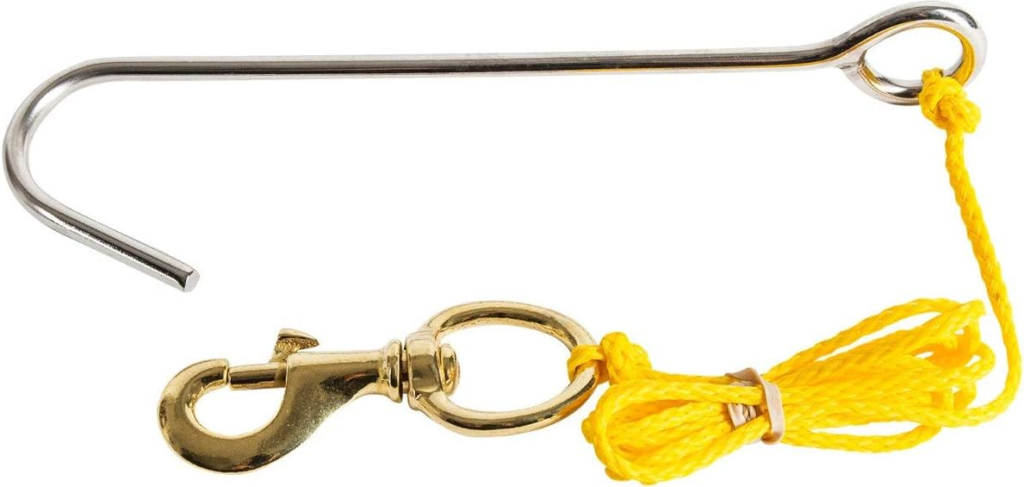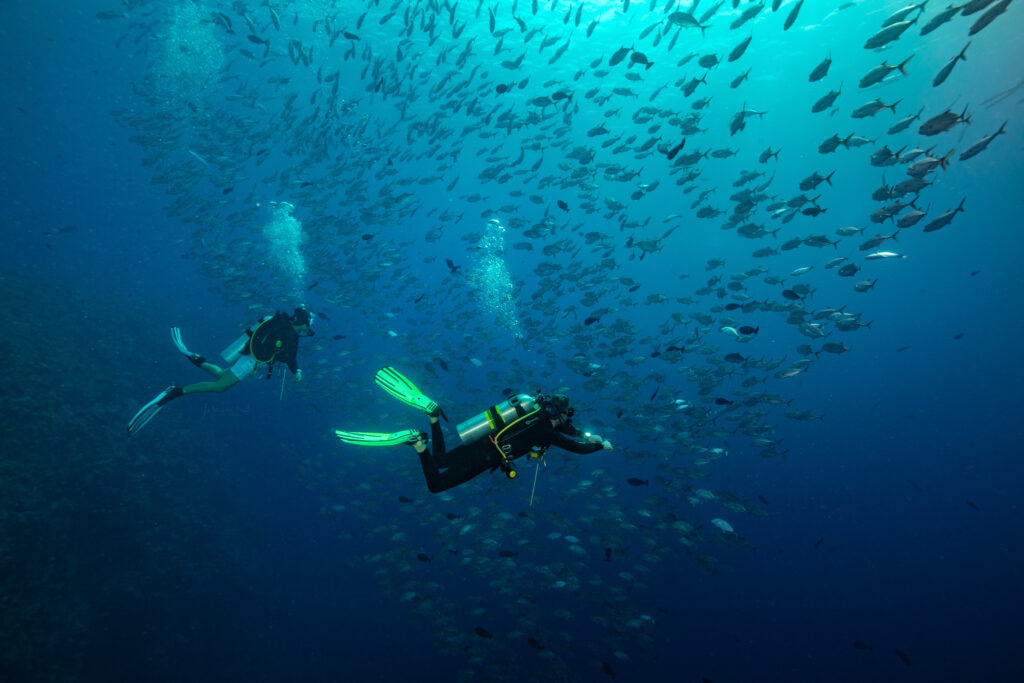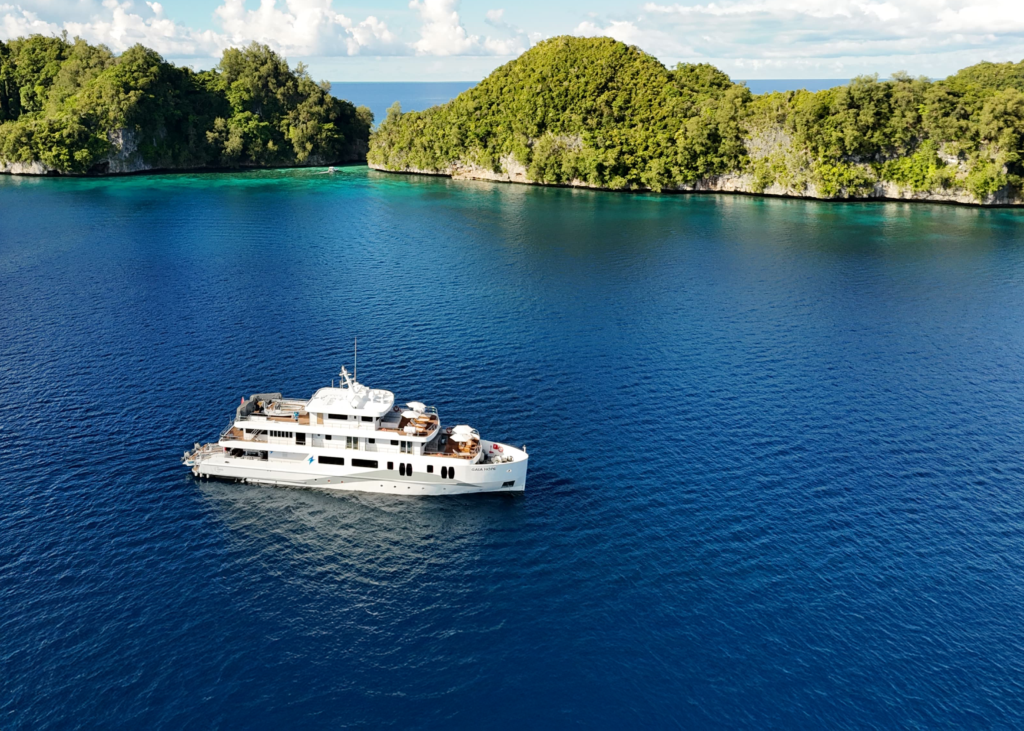Diving in strong currents isn’t for the faint of heart. Doing it safely requires skill, preparation, and the right gear to stay in control. That’s where the reef hook comes in: a simple, but essential tool that lets you hold your position without harming the reef.
But how does it actually work, and when should you use one? Let’s break down everything you need to know about reef hook diving!
What is Reef Hook Diving?

Reef hook diving is a technique that allows scuba divers to stabilize themselves in strong currents, rather than swim against them. Fighting the current can be exhausting, quickly draining energy and increasing the risk of being swept away. With a reef hook, you can stay in place with minimal effort, conserving energy and enhancing safety.
A reef hook typically consists of a handle, a sturdy line, and a hook made from durable, non-corrosive materials like stainless steel. To use it, divers secure the hook to a stable, non-living part of the reef or a rocky surface, allowing them to remain steady in the current without damaging marine life. This technique is especially useful for drift diving, where the flow of water is too strong to swim against.
Another reason why divers use reef hooks is to help protect the fragile marine environment. With a reef hook, you can maintain your position in the water without holding on to fragile corals. This makes them an essential tool for responsible diving, especially in areas with sensitive coral formations.
Where Are Reef Hooks Most Commonly Used?

Reef hooks are commonly used in destinations with strong currents. Though the powerful flows may present a challenge, they also attract pelagic marine life and offer adrenaline-pumping drift diving opportunities.
Here’s a list of some iconic dive destinations that may require reef hooks:
- Komodo National Park (Indonesia)
- Raja Ampat (Indonesia)
- Blue Corner (Palau)
- Galapagos Islands (Ecuador)
- Cocos Island (Costa Rica)
- Socorro Island (Mexico)
- Cozumel (Mexico)
- Brothers Island & Daedalus Reef (Egypt)
What Are the Benefits of Using Reef Hooks?
1. Energy Conservation

One of the main benefits of a reef hook is energy conservation. You get to reduce physical exhaustion by anchoring in place instead of fighting the currents. This also helps extend dive time and lower air consumption, allowing you to enjoy and focus on observing marine life while minimizing fatigue.
2. Environmental Protection
By hooking onto non-living structures like dead coral or rocks, you can avoid damaging live coral or fragile habitat. This in turn helps preserve the ecosystems for future divers. In addition, you can also reduce accidental fin kicks or sediment disturbance that can harm marine life.
3. Safety and Comfort

Using a reef hook can also prevent you from getting swept by the currents or separated from your group. This extra stability also makes challenging dive sites like drift walls a lot more manageable and enjoyable. In addition, if you’re an underwater photographer, capturing underwater wildlife like sharks and mantas can be a lot easier.
4. Responsible Exploration
Another benefit of the reef hook is that you can enjoy a responsible dive that minimizes damage to the corals, which further preserves the underwater habitat for marine life. This also means you’ll be playing a proactive role in protecting the ocean for future generations!
What Are the Risks and Challenges of Reef Hook Diving?
1. Environmental Risk
If you use a reef hook incorrectly, especially if you’re anchoring them to living things like coral, sponges, or sea fans, you might damage the corals and harm the ocean environment. Even small mistakes, like accidentally snagging the hook on the reef, can hurt these fragile ecosystems. Being careful with your reef hook helps protect underwater life and keeps these habitats healthy for the future.
2. Diver Safety Risk
Reef hook also has several safety risks you need to watch out for. You might experience some problems with the hook, such as the hook slipping off, the line breaking, or the anchor getting loosened in strong currents. If one of these things happens, you could lose control under the water. Another risk is getting tangled in the line if it snags on your gear or underwater debris. Because of this, always make sure that you’ve deployed your reef hook securely and pay attention to your surroundings.
To avoid any of these risks, make sure that you’ve had enough training or practice on how to use reef hooks before using them in areas with strong currents. You should also follow local guidelines and avoid reef hooks in sensitive or untested environments.
How Can You Properly and Safely Use Reef Hooks?
To minimize safety risks and ensure responsible diving, it’s important to use a reef hook correctly. Follow this step-by-step tutorial to safely stabilize yourself in strong currents:
1. Assess the Conditions and Choose the Right Anchor Point
Make sure that you only anchor your hook to non-living and stable surfaces, like rocks, dead corals, or sandy patches. Never anchor on live corals. You should also avoid areas with fragile marine life like sponges, sea fans, or loose debris that could be dislodged.
2. Deploy the Reef Hook Correctly
Hold the hook by the handle and carefully place it over your chosen anchor point. Let the current pull the hook into position and avoid forcing it. Remember to keep your body horizontal to minimize drag and adjust the line length so you’re not tugging at the reef.
3. Secure Yourself Safely
Attach the line to a D-ring on your BCD (not your waist or gear pockets) to avoid getting tangled. Maintain a relaxed grip on the line and never tie knots or wrap the line around your head.
4. Monitor Your Position and Surroundings
Check periodically to make sure the hook remains secure and hasn’t damaged the reef. Also, be mindful of other divers and marine life, avoiding any obstruction or sudden movements that could startle them.
5. Release the Hook Carefully
When you’re ready to move, gently unhook by pulling the line upward, not sideways, to avoid dislodging debris. Never yank the hook free, as this can harm the reef or send loose rocks tumbling.
Dive Safely and Responsibly with Solitude World’s Liveaboard and Resorts

For divers who venture into strong currents, mastering the use of a reef hook is essential for both safety and conservation. This simple allows you to stabilize yourself without harming the environment, making it a valuable addition to your dive gear.
If you’re looking for unforgettable drift diving experiences, Solitude World’s Liveaboard and Resorts offer expertly guided trips to some of the best current-rich dive sites. We have liveaboard vessels that can take you on an enchanting journey exploring some of the world’s best diving spots, primarily in Indonesia, the Philippines, and Palau.
Our vessels also have PADI-certified guides on board who can help you dive safely, spot local marine creatures, and practice environmentally responsible diving. Once you’re done with your underwater excursion, you can return to your cozy cabin or replenish your energy with our hearty, chef-prepared meals.
If you prefer land-based accommodation, our dive resorts in Indonesia and the Philippines provide full amenities for a comfortable stay. Plus, you can enhance your experience with expert-led underwater photography workshops, ensuring you capture stunning shots of your adventure.
What are you waiting for? Book your next diving adventure with us here today!